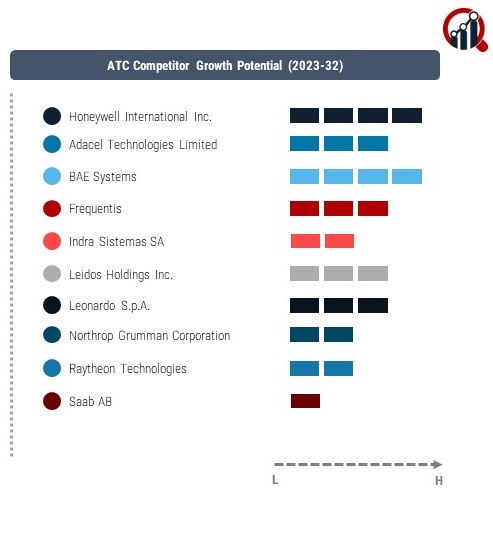Top Industry Leaders in the ATC Market

ATC Market Outlook
Key players in the ATC market employ various strategies to maintain and enhance their market positions. These include continuous investment in research and development to innovate and offer cutting-edge solutions, strategic partnerships and collaborations to expand their reach and capabilities, mergers and acquisitions to strengthen their product portfolios and geographical presence and focusing on customer-centric approaches to provide tailored solutions to meet specific needs.
Strategies Adopted By Key Players ATC Market
- Honeywell International Inc.
- Adacel Technologies Limited
- BAE Systems
- Frequentis
- Indra Sistemas SA
- Leidos Holdings Inc.
- Leonardo S.p.A.
- Northrop Grumman Corporation
- Raytheon Technologies
- Saab AB
- Thales Group
- Intelcan Technosystems Inc.
- Saipher ATC
- SkySoft
- L3Harris Technologies, Inc.
Factors for Market Share Analysis: Market share analysis in the ATC sector is influenced by several factors. These include technological advancements in radar systems, communication systems, and automation solutions, regulatory mandates and standards governing ATC operations, the emergence of new entrants with disruptive technologies, geopolitical factors impacting demand for ATC services, and evolving customer preferences for integrated and interoperable ATC solutions.
New and Emerging Companies: In addition to established players, several new and emerging companies are entering the ATC market with innovative technologies and solutions. These include startups focusing on unmanned traffic management (UTM), advanced surveillance systems, artificial intelligence (AI) for ATC automation, and satellite-based communication and navigation technologies. Companies such as Frequentis, Nav Canada, and Adacel Technologies are gaining traction in the market with their niche offerings and agile business models.
Industry News: Recent industry news highlights the growing demand for modernization and digitization of ATC infrastructure worldwide. Initiatives such as the deployment of remote tower systems, implementation of NextGen and SESAR programs, and adoption of digital towers and advanced data analytics are driving significant investments in the ATC sector. Moreover, collaborations between industry stakeholders, regulatory bodies, and technology providers are fostering innovation and accelerating the adoption of disruptive technologies in ATC operations.
Current Company Investment Trends: Leading players in the ATC market are investing heavily in research and development to enhance their product portfolios and stay ahead of the competition. Investments are focused on areas such as AI and machine learning for predictive analytics and decision support, cloud-based solutions for scalability and flexibility, cybersecurity to safeguard critical ATC infrastructure, and sustainability initiatives to reduce environmental footprint. Moreover, strategic investments in emerging markets with growing air traffic volumes are aimed at capitalizing on new opportunities and expanding market presence.
Overall Competitive Scenario: The ATC market is characterized by intense competition, driven by rapid technological advancements, evolving regulatory requirements, and increasing demand for efficient and safe airspace management solutions. Established players face competition from both traditional rivals and new entrants offering disruptive technologies. To maintain competitiveness, companies are adopting agile business models, fostering innovation through collaboration and partnerships, and focusing on delivering value-added services to their customers. The competitive landscape of the ATC market is expected to remain dynamic, with continuous shifts in market share and strategic alliances shaping the industry's future trajectory.
Recent Development:
June 2023, Collins Aerospace, a part of Raytheon Technologies, was chosen for eight projects by the European Union's SESAR 3 Joint Undertaking (SESAR 3 JU) to advance the Digital European Sky initiative. These projects will focus on various aspects of air traffic management, including connectivity, U-space, and autonomy. Collins will spearhead the JARVIS project, utilizing AI-based automation to enhance flight deck and control tower operations. Saab, in collaboration with Conlog Oy, introduced the r-TWR Deployable system in the same month. This portable version of remote tower air traffic management technology is designed for remote and disaster relief operations. The system comprises twin containers for easy transport via land vehicle or C-130 airlifter, housing cameras, infrared cameras, signal lights, and other equipment, powered by an integrated diesel generator.














